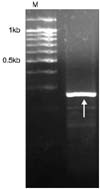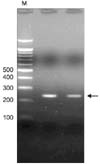Abstract
Purpose
Chlamydia trachomatis infection is the most common bacterial sexually transmitted disease. It is generally accepted that female commercial sex workers (FCSWs) are at an increased risk of incurring sexually transmitted disease (STD) because of their high numbers of sexual partners. Even though chlamydial infections in FCSWs have been linked with serious public health problems, there are very few reports about the prevalence of chlamydial infection in FCSWs in Korea. The purpose of this study was to determine the prevalence of chlamydial infection in FCSWs by performing cryptic plasmid gene amplification.
Materials and Methods
Genomic DNAs were extracted from the endocervical cotton swabs taken from 410 FCSWs in one Korean health center from April 2004 to August 2004; these FCSWs had visited there for periodic STD check ups. The human beta-globin and cryptic plasmid of Chlamydia trachomatis from the genomic DNA were amplified by the polymerase chain reaction (PCR) method.
Figures and Tables
 | Fig. 1Polymerase chain reaction (PCR) results of human beta-globin (arrow). All the samples show a band of human beta-globin, which is a housekeeper gene. M: 100bp DNA ladder marker (Promega). |
References
1. Groseclose SL, Zaidi AA, DeLisle SJ, Levine WC, St Louis ME. Estimated incidence and prevalence of genital Chlamydia trachomatis infections in the United States, 1996. Sex Transm Dis. 1999. 26:339–344.
2. Stamm WE. Holmes KK, Sparling PF, Mardh P, Lemon SM, Stamm WE, Piot P, editors. Chlamydia trachomatis infections of the adult. Sexually transmitted diseases. 1999. 3rd ed. New York: McGraw-Hill;407–422.
3. Clinical Effectiveness Group (Association of Genitourinary Medicine and the Medical Society for the Study of Venereal Diseases). National guideline for the management of Chlamydia trachomatis genital tract infection. Sex Transm Infect. 1999. 75:Suppl 1. S4–S8.
4. Humblet O, Paul C, Dickson N. Core group evolution over time: high-risk sexual behavior in a birth cohort between sexual debut and age 26. Sex Transm Dis. 2003. 30:818–824.
5. Lee SJ, Cho YH, Ha US, Kim SW, Yoon MS, Bae K. Sexual behavior survey and screening for chlamydia and gonorrhea in University students in South Korea. Int J Urol. 2005. 12:187–193.
6. Lee SJ, Cho YH, Kim CS, Shim BS, Cho IR, Chung JI, et al. Screening for Chlamydia and gonorrhea by strand displacement amplification in homeless adolescents attending youth shelters in Korea. J Korean Med Sci. 2004. 19:495–500.
7. Widjaja S, Cohen S, Brady WE, O'reilly K, Susanto , Wibowo A, et al. Evaluation of a rapid assay for detection of Chlamydia trachomatis infections in outpatient clinics in South Kalimantan, Indonesia. J Clin Microbiol. 1999. 37:4183–4185.
8. Black CM. Current methods of laboratory diagnosis of Chlamydia trachomatis infections. Clin Microbiol Rev. 1997. 10:160–184.
9. Kim BR, Lee GH. A semi-nested polymerase chain reaction for amplification of Chlamydia trachomatis omp1 gene. Korean J Urol. 2003. 44:812–818.
10. Moulder JW. Barron AL, editor. Characteristics of Chlamydia. Microbiology of Chlamydia. 1988. Boca Raton: CRC Press;4–19.
11. Johnson RE, Green TA, Schachter J, Jones RB, Hook EW 3rd, Black CM, et al. Evaluation of nucleic acid amplification tests as reference tests for Chlamydia trachomatis infections in asymptomatic men. J Clin Microbiol. 2000. 38:4382–4386.
12. Pate MS, Hook EW 3rd. Laboratory to laboratory variation in Chlamydia trachomatis culture practices. Sex Transm Dis. 1995. 22:322–326.
13. Pasternack R, Vuorinen P, Pitkajarvi T, Koskela M, Miettinen A. Comparison of manual Amplicor PCR, Cobas Amplicor PCR, and LCx assays for detection of Chlamydia trachomatis infection in women by using urine specimens. J Clin Microbiol. 1997. 35:402–405.
14. Davis JD, Riley PK, Peters CW, Rand KH. A comparison of ligase chain reaction to polymerase chain reaction in the detection of Chlamydia trachomatis endocervical infections. Infect Dis Obstet Gynecol. 1998. 6:57–60.
15. Mahony JB, Luinstra KE, Sellors JW, Chernesky MA. Comparison of plasmid- and chromosome-based polymerase chain reaction assays for detecting Chlamydia trachomatis nucleic acids. J Clin Microbiol. 1993. 31:1753–1758.
16. Poulin C, Alary M, Bernier F, Carbonneau D, Boily MC, Joly JR. Prevalence of Chlamydia trachomatis and Neisseria gonorrhoeae among at-risk women, young sex workers, and street youth attending community organizations in Quebec City, Canada. Sex Transm Dis. 2001. 28:437–443.
17. Gertig DM, Kapiga SH, Shao JF, Hunter DJ. Risk factors for sexually transmitted diseases among women attending family planning clinics in Dar-es-Salaam, Tanzania. Genitourin Med. 1997. 73:39–43.
18. Lee G, Kim B, Byun OM, Yoon WY, Song IH. Evaluation of a rapid test for detection of Chlamydia trachomatis infection to female commercial sex workers in Korea. Korean J Urol. 2004. 45:Suppl 2. S138.




 PDF
PDF ePub
ePub Citation
Citation Print
Print




 XML Download
XML Download